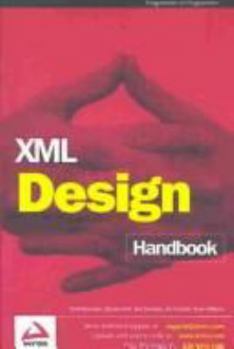XML Design Handbook
No Synopsis Available.
Format:Paperback
Language:English
ISBN:186100768X
ISBN13:9781861007681
Release Date:February 2003
Publisher:Wrox Press
Length:400 Pages
Weight:0.96 lbs.
Dimensions:0.7" x 6.0" x 9.2"
Customer Reviews
4 ratings
Good advice for experienced XML engineers
Published by Thriftbooks.com User , 21 years ago
This is not an introductory book on XML. At least one year of XML experience is recommended. With that, you'll get good advice on a wide variety of topics. Most people won't use all this information all at once, but it's at least good to know the strengths and weaknesses of XML from storage to access to presentation.Chapter 1 (Architecture Strategies) gives basic information on where XML can fit into your solution, with a simple example. This was easy reading.Chapter 2 (Basic Document Design) describes narrative vs. data-centric documents, storing text in XML elements vs. attributes, and data modeling pitfalls. There were good recommendations here.Chapter 3 (XML Schema Design) provides good strategies on validation, schema flexibility and re-use, and namespace use. Also important is the section on Russian Doll Design, Salami Slice Design and the Venetian Blind Model; much of this info can be found on the Internet (e.g. at www.xfront.com) but this book does a good comparison and contrast. The information on constraints is basic, but ideas on representing null values are useful.Chapter 4 (Parsing Strategies) covers DOM, SAX, and the little-used pull parsing, plus when and how to use each methodology.Chapter 5 (XSLT Strategies) provides a lot of nuts-n-bolts details on different transformation topics. Chapter 6 (XML Storage and Archiving) gives an overview of storing data as native XML, relational data, and hybrid approaches. Advantages and disadvantages for each are covered. Using a database (or not) in your product is a big decision, so this gives a good foundation for more research....Chapter 7 (Presentation Strategies) gives general info on configurability, personalization, performance, use of rich media (video, audio, animation, etc.), cross-platform support, 3rd-part data and software, maintainability and extensibility. The topics vary too much to give more than a few pages to each subject.Appendix A (Parser Performance) contains the details of testing on three Java-based parsers. For some reason, C++, .NET and Perl parsers were not included. As technologies evolve, the results of these tests are likely to become obsolete, though the methods may be useful to your own tests in the future.In summary, none of the subjects are covered in great depth, though in many cases the coverage is adequate and the few details are very useful. With this book you'll get a good foundation for well-designed and implemented XML solutions.
Excellent
Published by Thriftbooks.com User , 21 years ago
I found this book a great source for practical tips on how to design xml documents. Get it if you have a good grasp of the theory and have used xml before but don't have the experience to make great design decisions right away. All advice in this book comes from experience. It confirmed some of my own, but more often, served as an eye-opener.This statement on the back cover sums it up: "The problem here is not really a lack of information (there are many books and online resources on xml out there). The problem is a lack of reliable advice on how to use these technologies correctly and efficiently."I highly recommend it.
Excellent
Published by Thriftbooks.com User , 21 years ago
I found this book a great source for practical tips on how to design xml documents. Get it if you have a good grasp of the theory and have used xml on occasion but don't have the experience to make great design decisions right away. All of the advice you find in this book comes from experience. It confirmed some of my own, but more often, served as an eye-opener.This statement on the back cover sums it up: "The problem here is not really a lack of information (there are many books and online resources on xml out there). The problem is a lack of reliable advice on how to use these technologies correctly and efficiently."I highly recommend it.
Excellent
Published by Thriftbooks.com User , 21 years ago
I found this book an excellent source for practical tips on how to design xml documents. Get it if you have have a good grasp of the theory and have used xml on occasion but don't have the experience to make great design decisions right away. All of the advice you find in this book comes from experience. It confirmed some of my own, but more often, served as an eye-opener.This statement on the back cover sums it up: "The problem here is not really a lack of information (there are many books and online resources on xml out there). The problem is a lack of reliable advice on how to use these technologies correctly and efficiently."Get it.





